HRM Functions, Legislation & Workforce Planning: Takeaway Shop
VerifiedAdded on 2023/06/11
|11
|3282
|232
Report
AI Summary
This report provides an analysis of Human Resources Management (HRM) practices within a fictional company, 'The Takeaway Shop,' focusing on workforce planning, recruitment methods, employee relations, and the influence of employment legislation. It begins by explaining the purpose and functions of HRM in workforce planning and resourcing, highlighting the importance of recruiting talented employees to maximize performance and achieve company goals. The report then evaluates the strengths and weaknesses of various recruitment methods, including direct (internal) and indirect (external) approaches, discussing their impact on efficiency and innovation. Furthermore, it explains the benefits of different HRM practices for both employees and employers, such as training programs and attractive remuneration packages, and assesses the effectiveness of HRM practices in raising organizational profits and productivity. The analysis extends to employee relations, examining how recruitment processes, job security, and conflict resolution affect HRM's decision-making processes. Finally, the report identifies key elements of employment legislation and their influence on HRM decisions, concluding with a summary of the importance of effective HRM practices in achieving organizational success. Desklib provides access to similar assignments and study tools for students.
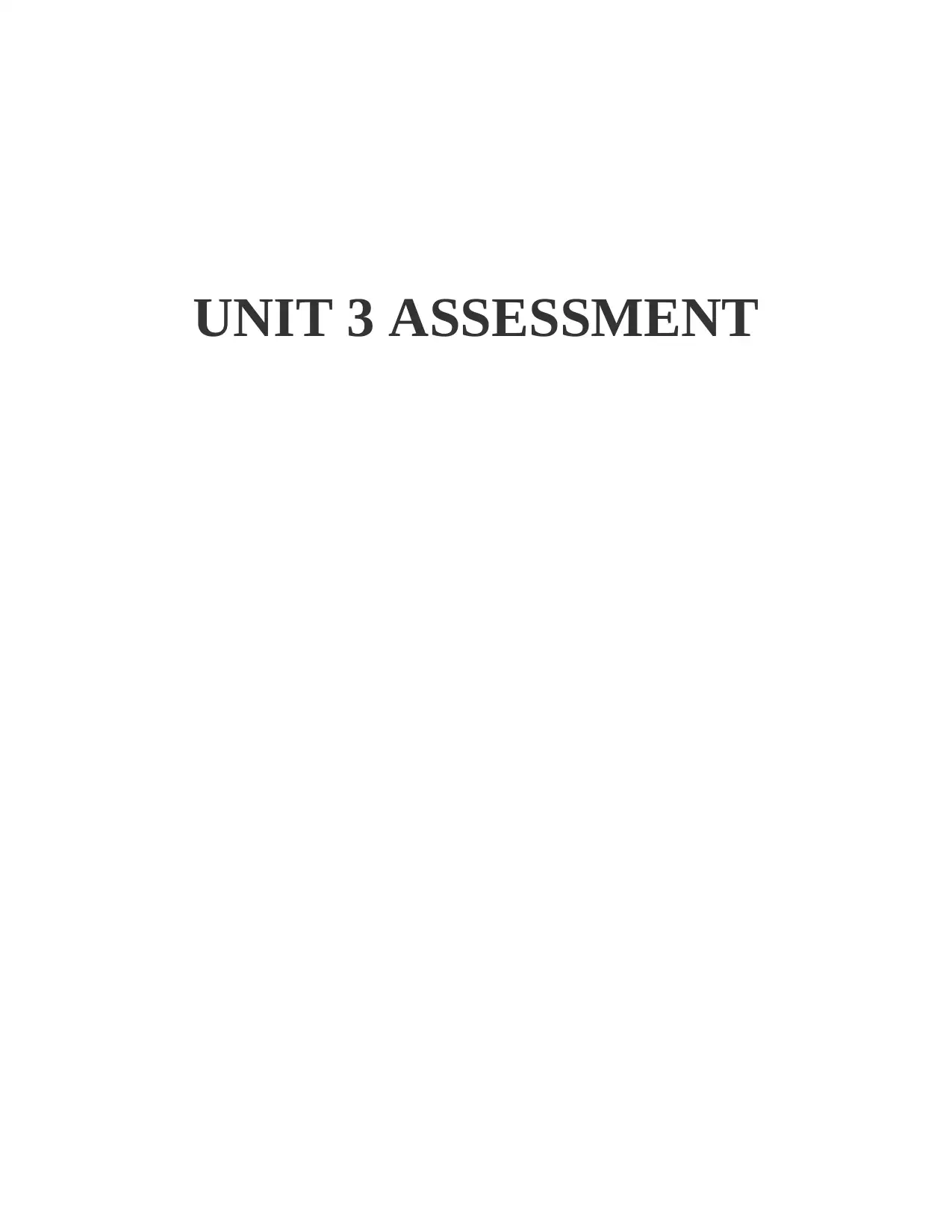
UNIT 3 ASSESSMENT
Paraphrase This Document
Need a fresh take? Get an instant paraphrase of this document with our AI Paraphraser
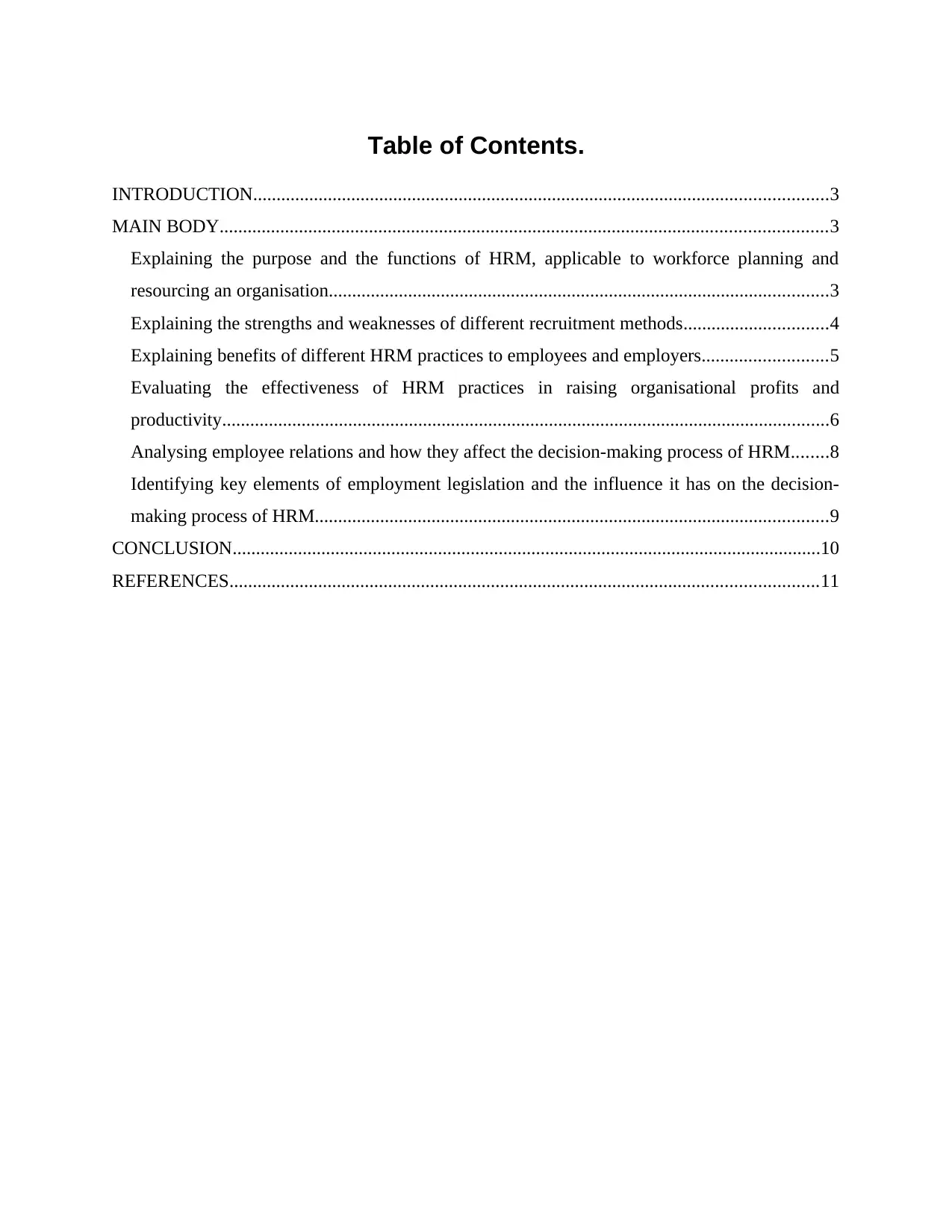
Table of Contents.
INTRODUCTION...........................................................................................................................3
MAIN BODY..................................................................................................................................3
Explaining the purpose and the functions of HRM, applicable to workforce planning and
resourcing an organisation...........................................................................................................3
Explaining the strengths and weaknesses of different recruitment methods...............................4
Explaining benefits of different HRM practices to employees and employers...........................5
Evaluating the effectiveness of HRM practices in raising organisational profits and
productivity..................................................................................................................................6
Analysing employee relations and how they affect the decision-making process of HRM........8
Identifying key elements of employment legislation and the influence it has on the decision-
making process of HRM..............................................................................................................9
CONCLUSION..............................................................................................................................10
REFERENCES..............................................................................................................................11
INTRODUCTION...........................................................................................................................3
MAIN BODY..................................................................................................................................3
Explaining the purpose and the functions of HRM, applicable to workforce planning and
resourcing an organisation...........................................................................................................3
Explaining the strengths and weaknesses of different recruitment methods...............................4
Explaining benefits of different HRM practices to employees and employers...........................5
Evaluating the effectiveness of HRM practices in raising organisational profits and
productivity..................................................................................................................................6
Analysing employee relations and how they affect the decision-making process of HRM........8
Identifying key elements of employment legislation and the influence it has on the decision-
making process of HRM..............................................................................................................9
CONCLUSION..............................................................................................................................10
REFERENCES..............................................................................................................................11
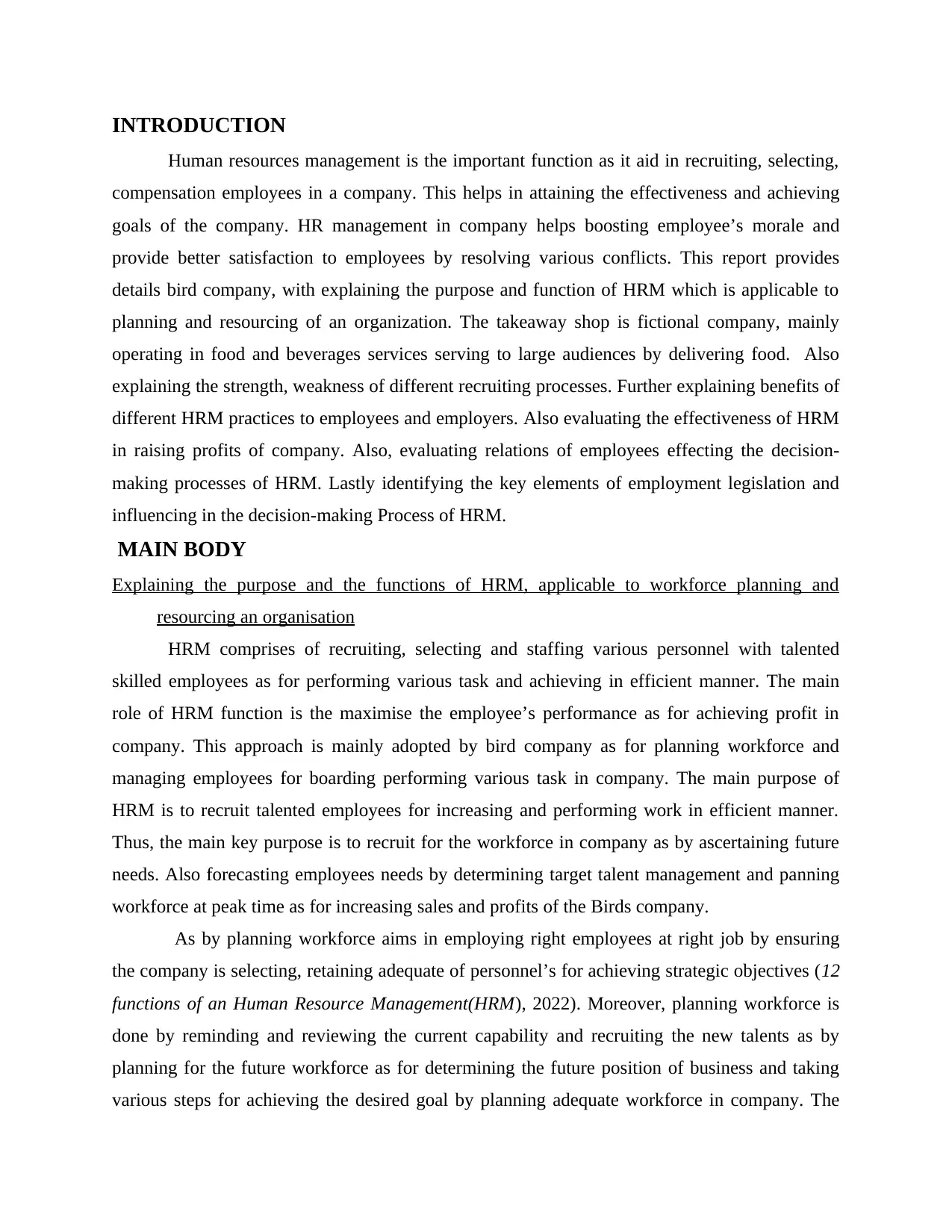
INTRODUCTION
Human resources management is the important function as it aid in recruiting, selecting,
compensation employees in a company. This helps in attaining the effectiveness and achieving
goals of the company. HR management in company helps boosting employee’s morale and
provide better satisfaction to employees by resolving various conflicts. This report provides
details bird company, with explaining the purpose and function of HRM which is applicable to
planning and resourcing of an organization. The takeaway shop is fictional company, mainly
operating in food and beverages services serving to large audiences by delivering food. Also
explaining the strength, weakness of different recruiting processes. Further explaining benefits of
different HRM practices to employees and employers. Also evaluating the effectiveness of HRM
in raising profits of company. Also, evaluating relations of employees effecting the decision-
making processes of HRM. Lastly identifying the key elements of employment legislation and
influencing in the decision-making Process of HRM.
MAIN BODY
Explaining the purpose and the functions of HRM, applicable to workforce planning and
resourcing an organisation
HRM comprises of recruiting, selecting and staffing various personnel with talented
skilled employees as for performing various task and achieving in efficient manner. The main
role of HRM function is the maximise the employee’s performance as for achieving profit in
company. This approach is mainly adopted by bird company as for planning workforce and
managing employees for boarding performing various task in company. The main purpose of
HRM is to recruit talented employees for increasing and performing work in efficient manner.
Thus, the main key purpose is to recruit for the workforce in company as by ascertaining future
needs. Also forecasting employees needs by determining target talent management and panning
workforce at peak time as for increasing sales and profits of the Birds company.
As by planning workforce aims in employing right employees at right job by ensuring
the company is selecting, retaining adequate of personnel’s for achieving strategic objectives (12
functions of an Human Resource Management(HRM), 2022). Moreover, planning workforce is
done by reminding and reviewing the current capability and recruiting the new talents as by
planning for the future workforce as for determining the future position of business and taking
various steps for achieving the desired goal by planning adequate workforce in company. The
Human resources management is the important function as it aid in recruiting, selecting,
compensation employees in a company. This helps in attaining the effectiveness and achieving
goals of the company. HR management in company helps boosting employee’s morale and
provide better satisfaction to employees by resolving various conflicts. This report provides
details bird company, with explaining the purpose and function of HRM which is applicable to
planning and resourcing of an organization. The takeaway shop is fictional company, mainly
operating in food and beverages services serving to large audiences by delivering food. Also
explaining the strength, weakness of different recruiting processes. Further explaining benefits of
different HRM practices to employees and employers. Also evaluating the effectiveness of HRM
in raising profits of company. Also, evaluating relations of employees effecting the decision-
making processes of HRM. Lastly identifying the key elements of employment legislation and
influencing in the decision-making Process of HRM.
MAIN BODY
Explaining the purpose and the functions of HRM, applicable to workforce planning and
resourcing an organisation
HRM comprises of recruiting, selecting and staffing various personnel with talented
skilled employees as for performing various task and achieving in efficient manner. The main
role of HRM function is the maximise the employee’s performance as for achieving profit in
company. This approach is mainly adopted by bird company as for planning workforce and
managing employees for boarding performing various task in company. The main purpose of
HRM is to recruit talented employees for increasing and performing work in efficient manner.
Thus, the main key purpose is to recruit for the workforce in company as by ascertaining future
needs. Also forecasting employees needs by determining target talent management and panning
workforce at peak time as for increasing sales and profits of the Birds company.
As by planning workforce aims in employing right employees at right job by ensuring
the company is selecting, retaining adequate of personnel’s for achieving strategic objectives (12
functions of an Human Resource Management(HRM), 2022). Moreover, planning workforce is
done by reminding and reviewing the current capability and recruiting the new talents as by
planning for the future workforce as for determining the future position of business and taking
various steps for achieving the desired goal by planning adequate workforce in company. The
⊘ This is a preview!⊘
Do you want full access?
Subscribe today to unlock all pages.

Trusted by 1+ million students worldwide
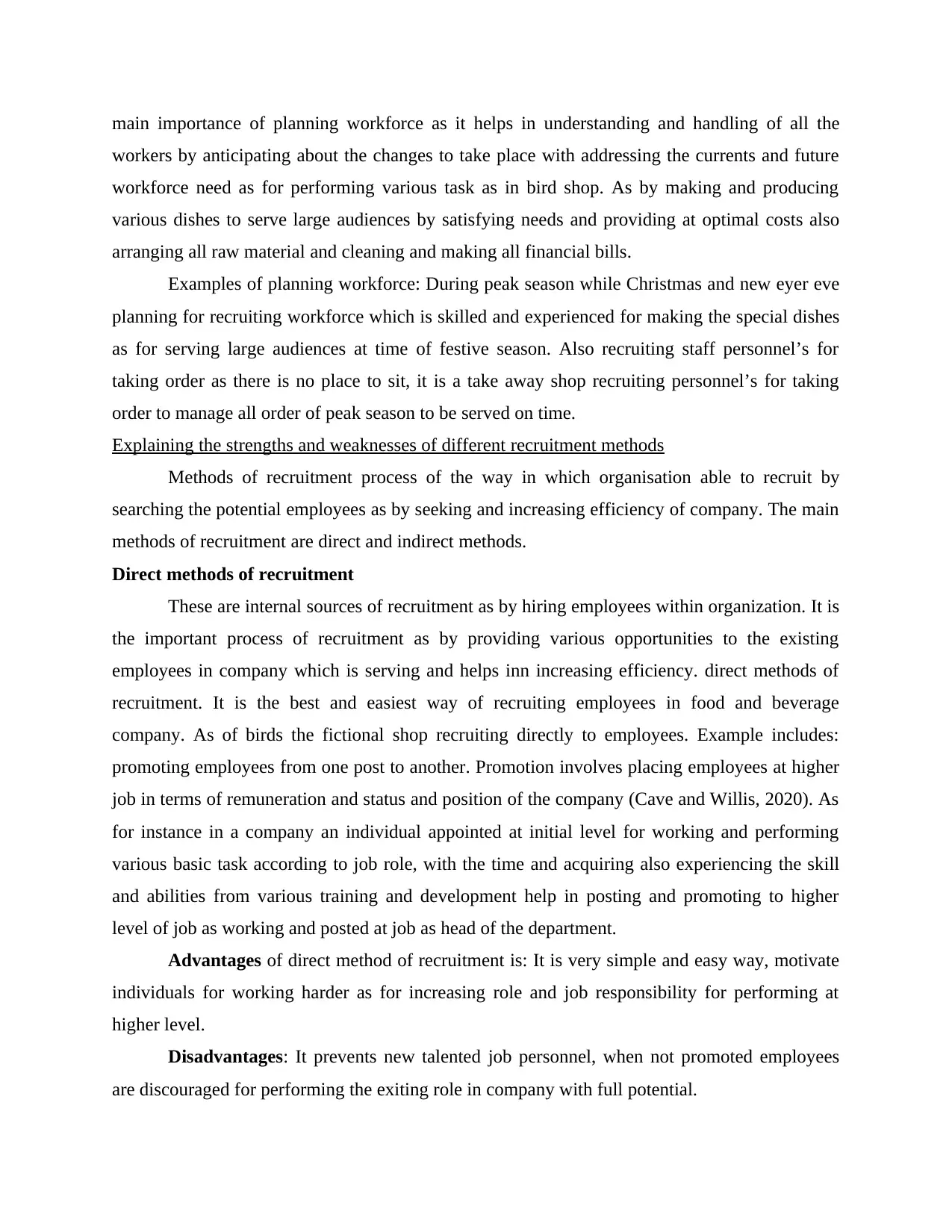
main importance of planning workforce as it helps in understanding and handling of all the
workers by anticipating about the changes to take place with addressing the currents and future
workforce need as for performing various task as in bird shop. As by making and producing
various dishes to serve large audiences by satisfying needs and providing at optimal costs also
arranging all raw material and cleaning and making all financial bills.
Examples of planning workforce: During peak season while Christmas and new eyer eve
planning for recruiting workforce which is skilled and experienced for making the special dishes
as for serving large audiences at time of festive season. Also recruiting staff personnel’s for
taking order as there is no place to sit, it is a take away shop recruiting personnel’s for taking
order to manage all order of peak season to be served on time.
Explaining the strengths and weaknesses of different recruitment methods
Methods of recruitment process of the way in which organisation able to recruit by
searching the potential employees as by seeking and increasing efficiency of company. The main
methods of recruitment are direct and indirect methods.
Direct methods of recruitment
These are internal sources of recruitment as by hiring employees within organization. It is
the important process of recruitment as by providing various opportunities to the existing
employees in company which is serving and helps inn increasing efficiency. direct methods of
recruitment. It is the best and easiest way of recruiting employees in food and beverage
company. As of birds the fictional shop recruiting directly to employees. Example includes:
promoting employees from one post to another. Promotion involves placing employees at higher
job in terms of remuneration and status and position of the company (Cave and Willis, 2020). As
for instance in a company an individual appointed at initial level for working and performing
various basic task according to job role, with the time and acquiring also experiencing the skill
and abilities from various training and development help in posting and promoting to higher
level of job as working and posted at job as head of the department.
Advantages of direct method of recruitment is: It is very simple and easy way, motivate
individuals for working harder as for increasing role and job responsibility for performing at
higher level.
Disadvantages: It prevents new talented job personnel, when not promoted employees
are discouraged for performing the exiting role in company with full potential.
workers by anticipating about the changes to take place with addressing the currents and future
workforce need as for performing various task as in bird shop. As by making and producing
various dishes to serve large audiences by satisfying needs and providing at optimal costs also
arranging all raw material and cleaning and making all financial bills.
Examples of planning workforce: During peak season while Christmas and new eyer eve
planning for recruiting workforce which is skilled and experienced for making the special dishes
as for serving large audiences at time of festive season. Also recruiting staff personnel’s for
taking order as there is no place to sit, it is a take away shop recruiting personnel’s for taking
order to manage all order of peak season to be served on time.
Explaining the strengths and weaknesses of different recruitment methods
Methods of recruitment process of the way in which organisation able to recruit by
searching the potential employees as by seeking and increasing efficiency of company. The main
methods of recruitment are direct and indirect methods.
Direct methods of recruitment
These are internal sources of recruitment as by hiring employees within organization. It is
the important process of recruitment as by providing various opportunities to the existing
employees in company which is serving and helps inn increasing efficiency. direct methods of
recruitment. It is the best and easiest way of recruiting employees in food and beverage
company. As of birds the fictional shop recruiting directly to employees. Example includes:
promoting employees from one post to another. Promotion involves placing employees at higher
job in terms of remuneration and status and position of the company (Cave and Willis, 2020). As
for instance in a company an individual appointed at initial level for working and performing
various basic task according to job role, with the time and acquiring also experiencing the skill
and abilities from various training and development help in posting and promoting to higher
level of job as working and posted at job as head of the department.
Advantages of direct method of recruitment is: It is very simple and easy way, motivate
individuals for working harder as for increasing role and job responsibility for performing at
higher level.
Disadvantages: It prevents new talented job personnel, when not promoted employees
are discouraged for performing the exiting role in company with full potential.
Paraphrase This Document
Need a fresh take? Get an instant paraphrase of this document with our AI Paraphraser
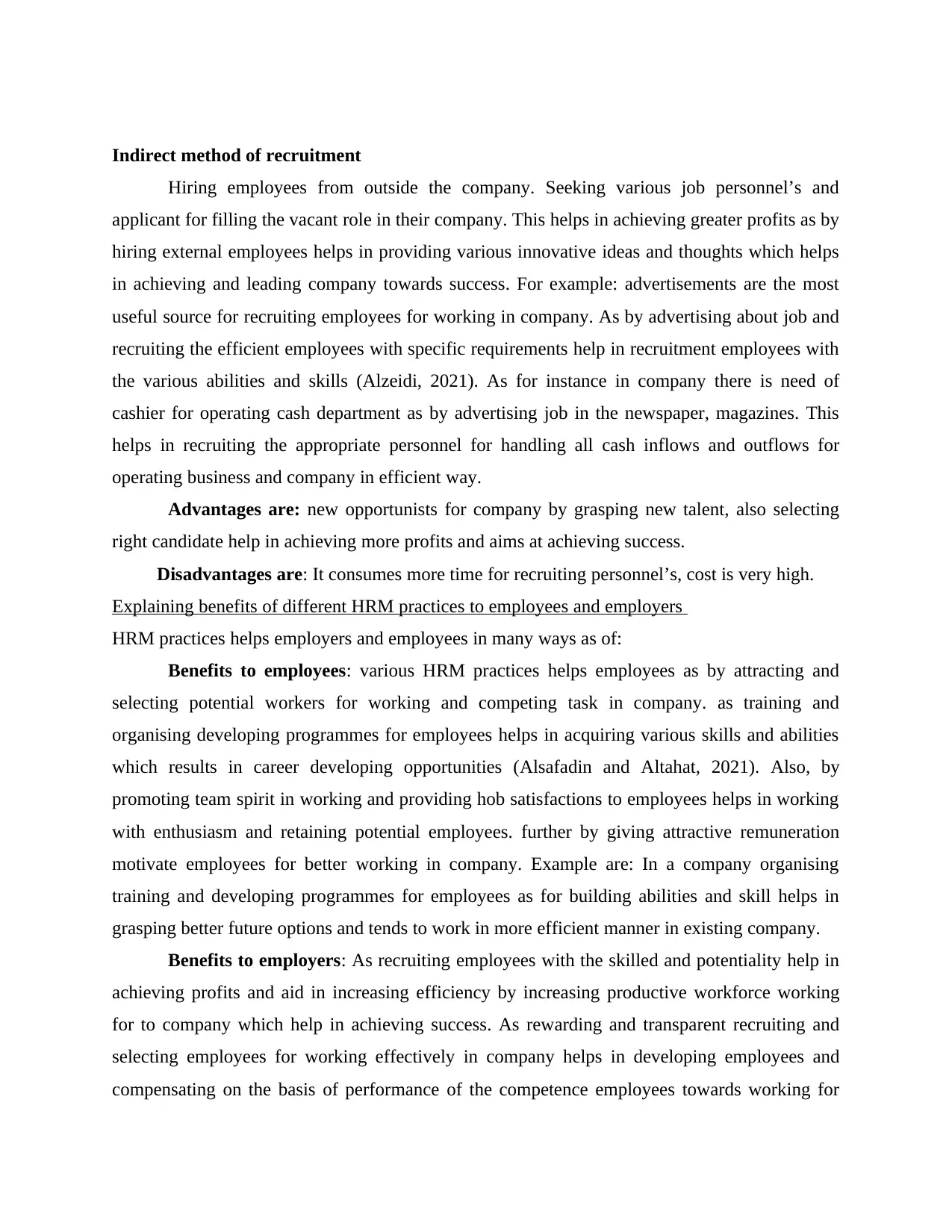
Indirect method of recruitment
Hiring employees from outside the company. Seeking various job personnel’s and
applicant for filling the vacant role in their company. This helps in achieving greater profits as by
hiring external employees helps in providing various innovative ideas and thoughts which helps
in achieving and leading company towards success. For example: advertisements are the most
useful source for recruiting employees for working in company. As by advertising about job and
recruiting the efficient employees with specific requirements help in recruitment employees with
the various abilities and skills (Alzeidi, 2021). As for instance in company there is need of
cashier for operating cash department as by advertising job in the newspaper, magazines. This
helps in recruiting the appropriate personnel for handling all cash inflows and outflows for
operating business and company in efficient way.
Advantages are: new opportunists for company by grasping new talent, also selecting
right candidate help in achieving more profits and aims at achieving success.
Disadvantages are: It consumes more time for recruiting personnel’s, cost is very high.
Explaining benefits of different HRM practices to employees and employers
HRM practices helps employers and employees in many ways as of:
Benefits to employees: various HRM practices helps employees as by attracting and
selecting potential workers for working and competing task in company. as training and
organising developing programmes for employees helps in acquiring various skills and abilities
which results in career developing opportunities (Alsafadin and Altahat, 2021). Also, by
promoting team spirit in working and providing hob satisfactions to employees helps in working
with enthusiasm and retaining potential employees. further by giving attractive remuneration
motivate employees for better working in company. Example are: In a company organising
training and developing programmes for employees as for building abilities and skill helps in
grasping better future options and tends to work in more efficient manner in existing company.
Benefits to employers: As recruiting employees with the skilled and potentiality help in
achieving profits and aid in increasing efficiency by increasing productive workforce working
for to company which help in achieving success. As rewarding and transparent recruiting and
selecting employees for working effectively in company helps in developing employees and
compensating on the basis of performance of the competence employees towards working for
Hiring employees from outside the company. Seeking various job personnel’s and
applicant for filling the vacant role in their company. This helps in achieving greater profits as by
hiring external employees helps in providing various innovative ideas and thoughts which helps
in achieving and leading company towards success. For example: advertisements are the most
useful source for recruiting employees for working in company. As by advertising about job and
recruiting the efficient employees with specific requirements help in recruitment employees with
the various abilities and skills (Alzeidi, 2021). As for instance in company there is need of
cashier for operating cash department as by advertising job in the newspaper, magazines. This
helps in recruiting the appropriate personnel for handling all cash inflows and outflows for
operating business and company in efficient way.
Advantages are: new opportunists for company by grasping new talent, also selecting
right candidate help in achieving more profits and aims at achieving success.
Disadvantages are: It consumes more time for recruiting personnel’s, cost is very high.
Explaining benefits of different HRM practices to employees and employers
HRM practices helps employers and employees in many ways as of:
Benefits to employees: various HRM practices helps employees as by attracting and
selecting potential workers for working and competing task in company. as training and
organising developing programmes for employees helps in acquiring various skills and abilities
which results in career developing opportunities (Alsafadin and Altahat, 2021). Also, by
promoting team spirit in working and providing hob satisfactions to employees helps in working
with enthusiasm and retaining potential employees. further by giving attractive remuneration
motivate employees for better working in company. Example are: In a company organising
training and developing programmes for employees as for building abilities and skill helps in
grasping better future options and tends to work in more efficient manner in existing company.
Benefits to employers: As recruiting employees with the skilled and potentiality help in
achieving profits and aid in increasing efficiency by increasing productive workforce working
for to company which help in achieving success. As rewarding and transparent recruiting and
selecting employees for working effectively in company helps in developing employees and
compensating on the basis of performance of the competence employees towards working for
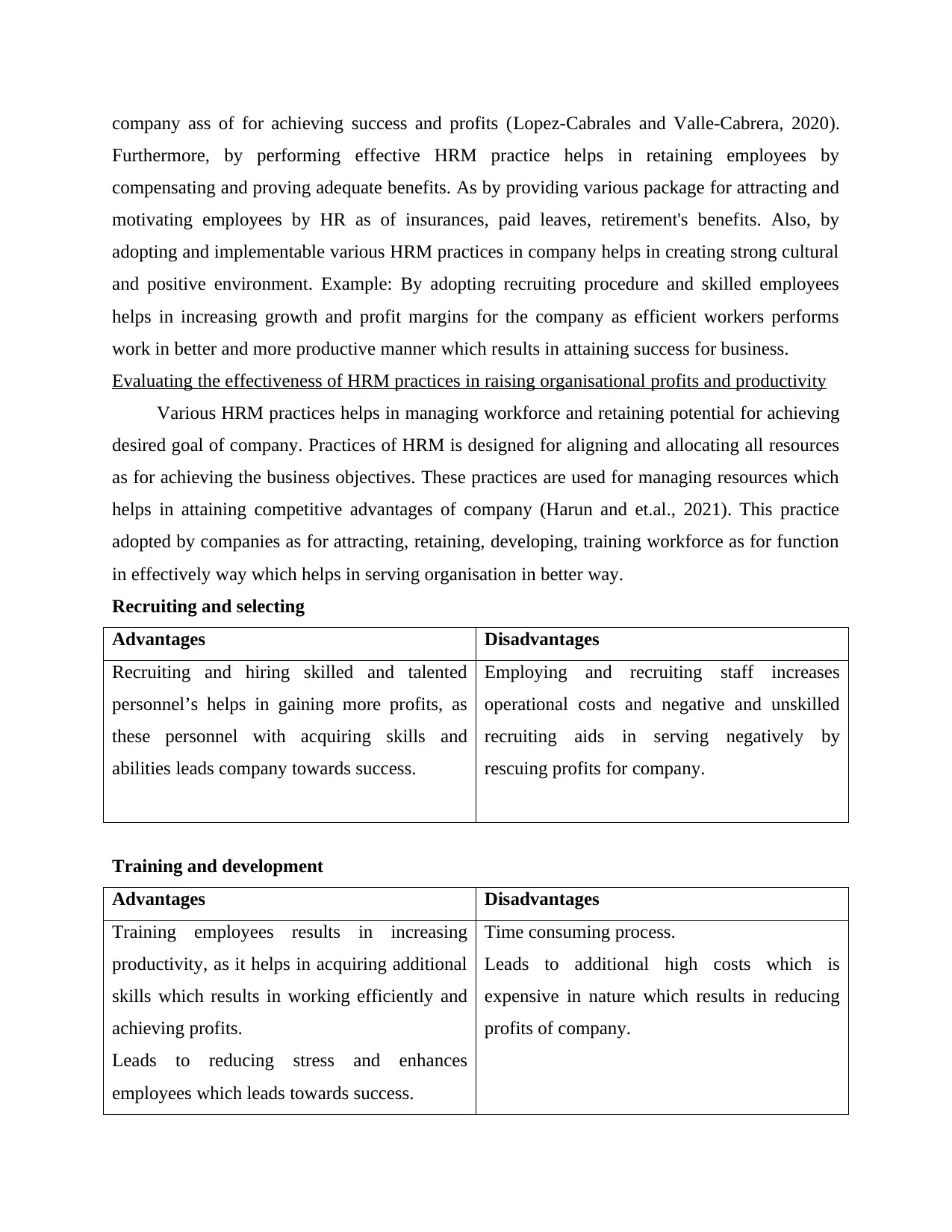
company ass of for achieving success and profits (Lopez-Cabrales and Valle-Cabrera, 2020).
Furthermore, by performing effective HRM practice helps in retaining employees by
compensating and proving adequate benefits. As by providing various package for attracting and
motivating employees by HR as of insurances, paid leaves, retirement's benefits. Also, by
adopting and implementable various HRM practices in company helps in creating strong cultural
and positive environment. Example: By adopting recruiting procedure and skilled employees
helps in increasing growth and profit margins for the company as efficient workers performs
work in better and more productive manner which results in attaining success for business.
Evaluating the effectiveness of HRM practices in raising organisational profits and productivity
Various HRM practices helps in managing workforce and retaining potential for achieving
desired goal of company. Practices of HRM is designed for aligning and allocating all resources
as for achieving the business objectives. These practices are used for managing resources which
helps in attaining competitive advantages of company (Harun and et.al., 2021). This practice
adopted by companies as for attracting, retaining, developing, training workforce as for function
in effectively way which helps in serving organisation in better way.
Recruiting and selecting
Advantages Disadvantages
Recruiting and hiring skilled and talented
personnel’s helps in gaining more profits, as
these personnel with acquiring skills and
abilities leads company towards success.
Employing and recruiting staff increases
operational costs and negative and unskilled
recruiting aids in serving negatively by
rescuing profits for company.
Training and development
Advantages Disadvantages
Training employees results in increasing
productivity, as it helps in acquiring additional
skills which results in working efficiently and
achieving profits.
Leads to reducing stress and enhances
employees which leads towards success.
Time consuming process.
Leads to additional high costs which is
expensive in nature which results in reducing
profits of company.
Furthermore, by performing effective HRM practice helps in retaining employees by
compensating and proving adequate benefits. As by providing various package for attracting and
motivating employees by HR as of insurances, paid leaves, retirement's benefits. Also, by
adopting and implementable various HRM practices in company helps in creating strong cultural
and positive environment. Example: By adopting recruiting procedure and skilled employees
helps in increasing growth and profit margins for the company as efficient workers performs
work in better and more productive manner which results in attaining success for business.
Evaluating the effectiveness of HRM practices in raising organisational profits and productivity
Various HRM practices helps in managing workforce and retaining potential for achieving
desired goal of company. Practices of HRM is designed for aligning and allocating all resources
as for achieving the business objectives. These practices are used for managing resources which
helps in attaining competitive advantages of company (Harun and et.al., 2021). This practice
adopted by companies as for attracting, retaining, developing, training workforce as for function
in effectively way which helps in serving organisation in better way.
Recruiting and selecting
Advantages Disadvantages
Recruiting and hiring skilled and talented
personnel’s helps in gaining more profits, as
these personnel with acquiring skills and
abilities leads company towards success.
Employing and recruiting staff increases
operational costs and negative and unskilled
recruiting aids in serving negatively by
rescuing profits for company.
Training and development
Advantages Disadvantages
Training employees results in increasing
productivity, as it helps in acquiring additional
skills which results in working efficiently and
achieving profits.
Leads to reducing stress and enhances
employees which leads towards success.
Time consuming process.
Leads to additional high costs which is
expensive in nature which results in reducing
profits of company.
⊘ This is a preview!⊘
Do you want full access?
Subscribe today to unlock all pages.

Trusted by 1+ million students worldwide
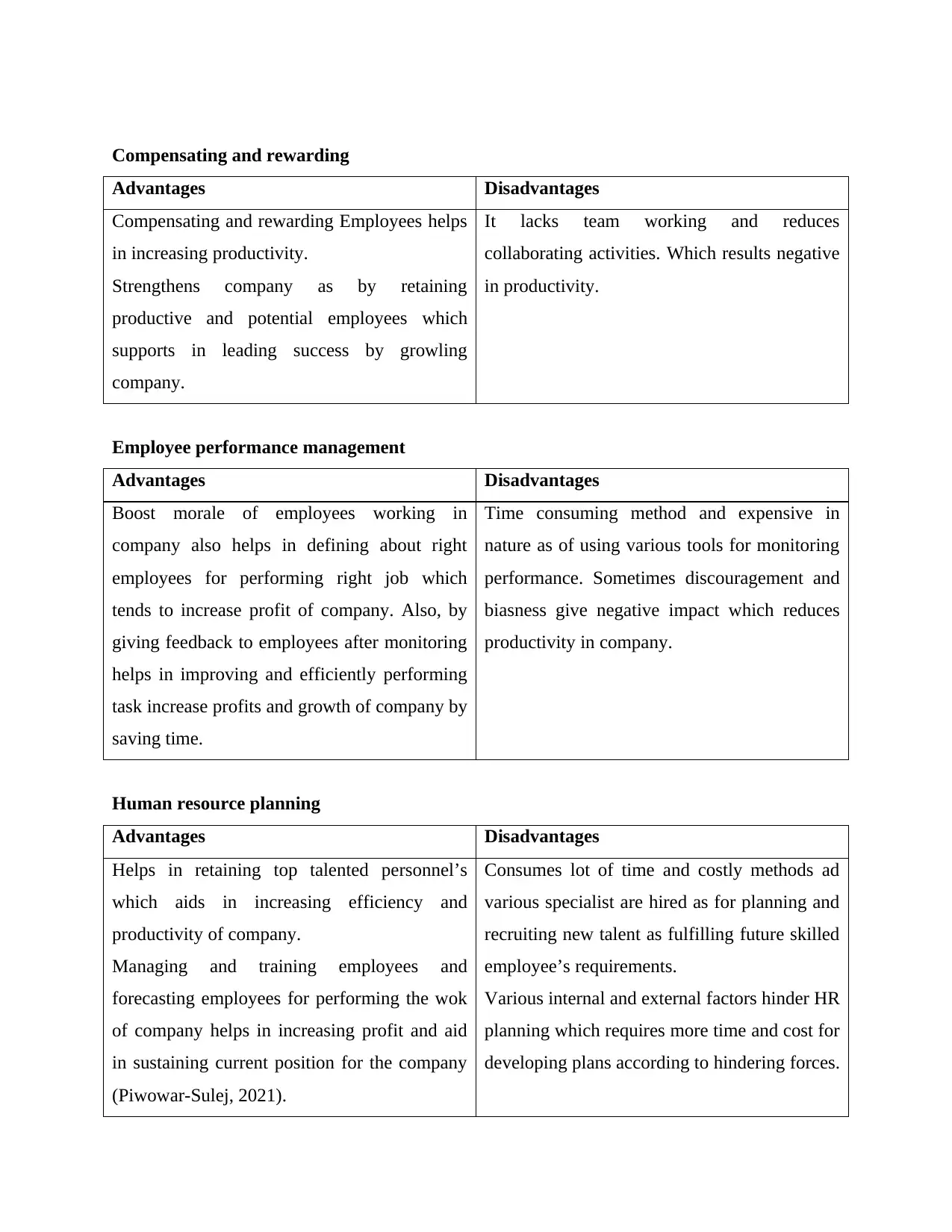
Compensating and rewarding
Advantages Disadvantages
Compensating and rewarding Employees helps
in increasing productivity.
Strengthens company as by retaining
productive and potential employees which
supports in leading success by growling
company.
It lacks team working and reduces
collaborating activities. Which results negative
in productivity.
Employee performance management
Advantages Disadvantages
Boost morale of employees working in
company also helps in defining about right
employees for performing right job which
tends to increase profit of company. Also, by
giving feedback to employees after monitoring
helps in improving and efficiently performing
task increase profits and growth of company by
saving time.
Time consuming method and expensive in
nature as of using various tools for monitoring
performance. Sometimes discouragement and
biasness give negative impact which reduces
productivity in company.
Human resource planning
Advantages Disadvantages
Helps in retaining top talented personnel’s
which aids in increasing efficiency and
productivity of company.
Managing and training employees and
forecasting employees for performing the wok
of company helps in increasing profit and aid
in sustaining current position for the company
(Piwowar‐Sulej, 2021).
Consumes lot of time and costly methods ad
various specialist are hired as for planning and
recruiting new talent as fulfilling future skilled
employee’s requirements.
Various internal and external factors hinder HR
planning which requires more time and cost for
developing plans according to hindering forces.
Advantages Disadvantages
Compensating and rewarding Employees helps
in increasing productivity.
Strengthens company as by retaining
productive and potential employees which
supports in leading success by growling
company.
It lacks team working and reduces
collaborating activities. Which results negative
in productivity.
Employee performance management
Advantages Disadvantages
Boost morale of employees working in
company also helps in defining about right
employees for performing right job which
tends to increase profit of company. Also, by
giving feedback to employees after monitoring
helps in improving and efficiently performing
task increase profits and growth of company by
saving time.
Time consuming method and expensive in
nature as of using various tools for monitoring
performance. Sometimes discouragement and
biasness give negative impact which reduces
productivity in company.
Human resource planning
Advantages Disadvantages
Helps in retaining top talented personnel’s
which aids in increasing efficiency and
productivity of company.
Managing and training employees and
forecasting employees for performing the wok
of company helps in increasing profit and aid
in sustaining current position for the company
(Piwowar‐Sulej, 2021).
Consumes lot of time and costly methods ad
various specialist are hired as for planning and
recruiting new talent as fulfilling future skilled
employee’s requirements.
Various internal and external factors hinder HR
planning which requires more time and cost for
developing plans according to hindering forces.
Paraphrase This Document
Need a fresh take? Get an instant paraphrase of this document with our AI Paraphraser
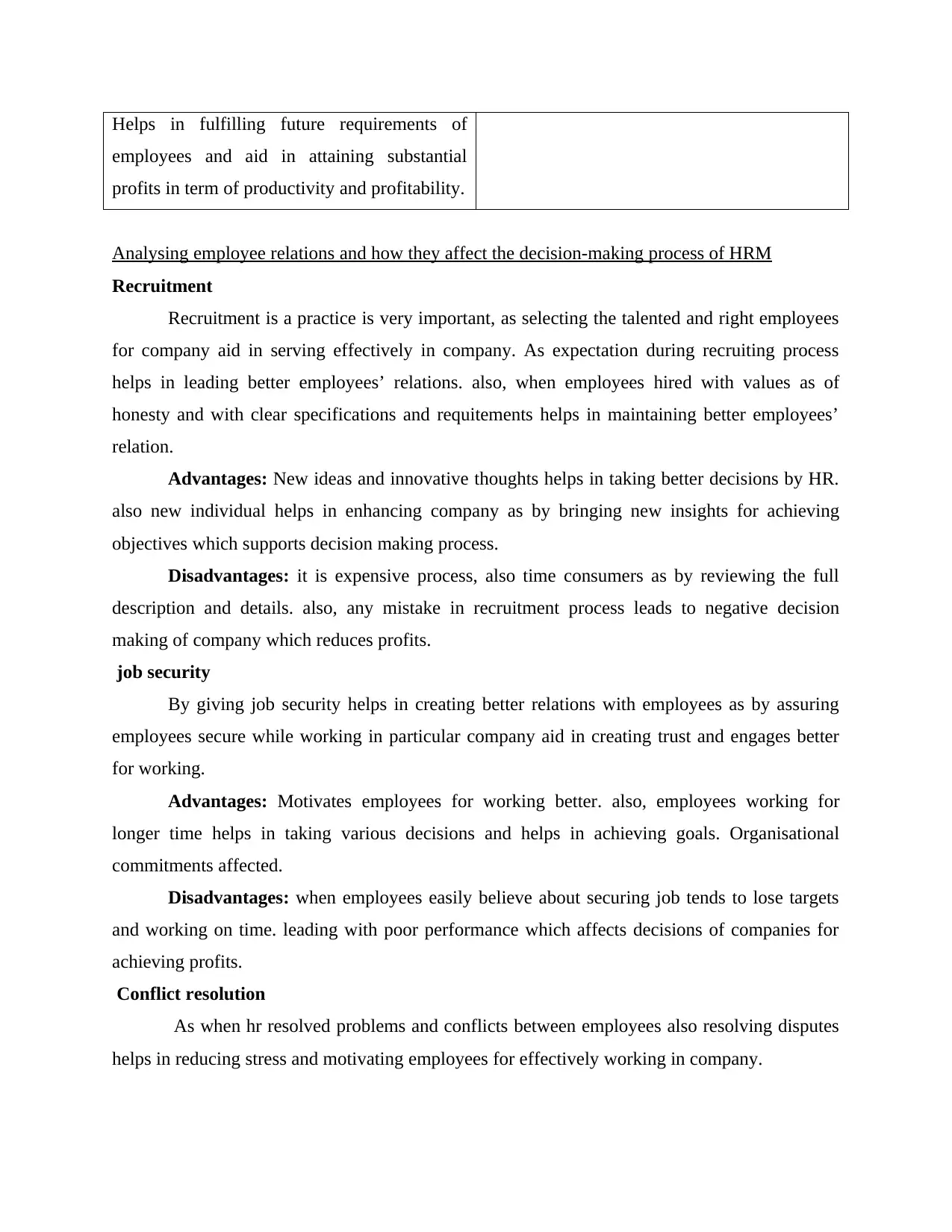
Helps in fulfilling future requirements of
employees and aid in attaining substantial
profits in term of productivity and profitability.
Analysing employee relations and how they affect the decision-making process of HRM
Recruitment
Recruitment is a practice is very important, as selecting the talented and right employees
for company aid in serving effectively in company. As expectation during recruiting process
helps in leading better employees’ relations. also, when employees hired with values as of
honesty and with clear specifications and requitements helps in maintaining better employees’
relation.
Advantages: New ideas and innovative thoughts helps in taking better decisions by HR.
also new individual helps in enhancing company as by bringing new insights for achieving
objectives which supports decision making process.
Disadvantages: it is expensive process, also time consumers as by reviewing the full
description and details. also, any mistake in recruitment process leads to negative decision
making of company which reduces profits.
job security
By giving job security helps in creating better relations with employees as by assuring
employees secure while working in particular company aid in creating trust and engages better
for working.
Advantages: Motivates employees for working better. also, employees working for
longer time helps in taking various decisions and helps in achieving goals. Organisational
commitments affected.
Disadvantages: when employees easily believe about securing job tends to lose targets
and working on time. leading with poor performance which affects decisions of companies for
achieving profits.
Conflict resolution
As when hr resolved problems and conflicts between employees also resolving disputes
helps in reducing stress and motivating employees for effectively working in company.
employees and aid in attaining substantial
profits in term of productivity and profitability.
Analysing employee relations and how they affect the decision-making process of HRM
Recruitment
Recruitment is a practice is very important, as selecting the talented and right employees
for company aid in serving effectively in company. As expectation during recruiting process
helps in leading better employees’ relations. also, when employees hired with values as of
honesty and with clear specifications and requitements helps in maintaining better employees’
relation.
Advantages: New ideas and innovative thoughts helps in taking better decisions by HR.
also new individual helps in enhancing company as by bringing new insights for achieving
objectives which supports decision making process.
Disadvantages: it is expensive process, also time consumers as by reviewing the full
description and details. also, any mistake in recruitment process leads to negative decision
making of company which reduces profits.
job security
By giving job security helps in creating better relations with employees as by assuring
employees secure while working in particular company aid in creating trust and engages better
for working.
Advantages: Motivates employees for working better. also, employees working for
longer time helps in taking various decisions and helps in achieving goals. Organisational
commitments affected.
Disadvantages: when employees easily believe about securing job tends to lose targets
and working on time. leading with poor performance which affects decisions of companies for
achieving profits.
Conflict resolution
As when hr resolved problems and conflicts between employees also resolving disputes
helps in reducing stress and motivating employees for effectively working in company.
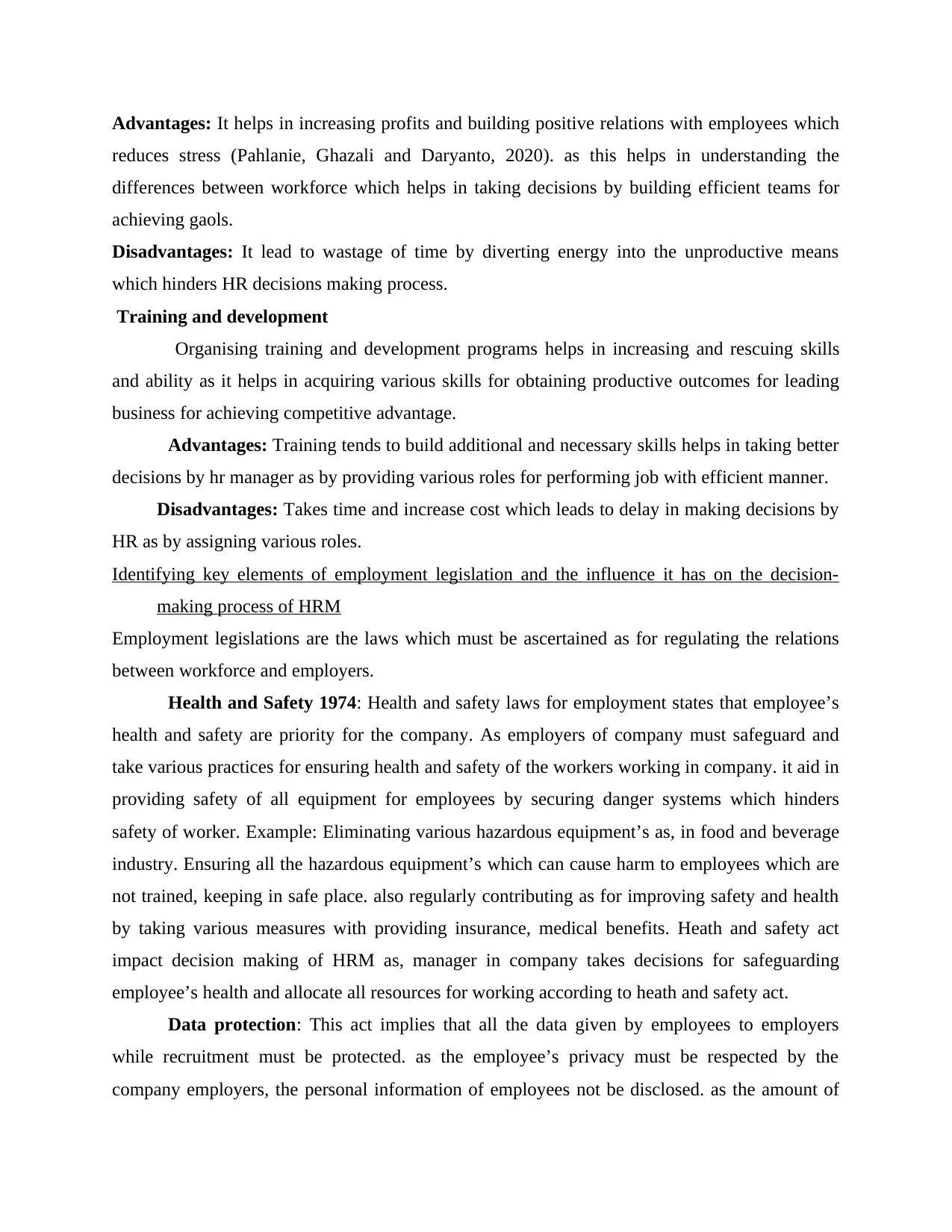
Advantages: It helps in increasing profits and building positive relations with employees which
reduces stress (Pahlanie, Ghazali and Daryanto, 2020). as this helps in understanding the
differences between workforce which helps in taking decisions by building efficient teams for
achieving gaols.
Disadvantages: It lead to wastage of time by diverting energy into the unproductive means
which hinders HR decisions making process.
Training and development
Organising training and development programs helps in increasing and rescuing skills
and ability as it helps in acquiring various skills for obtaining productive outcomes for leading
business for achieving competitive advantage.
Advantages: Training tends to build additional and necessary skills helps in taking better
decisions by hr manager as by providing various roles for performing job with efficient manner.
Disadvantages: Takes time and increase cost which leads to delay in making decisions by
HR as by assigning various roles.
Identifying key elements of employment legislation and the influence it has on the decision-
making process of HRM
Employment legislations are the laws which must be ascertained as for regulating the relations
between workforce and employers.
Health and Safety 1974: Health and safety laws for employment states that employee’s
health and safety are priority for the company. As employers of company must safeguard and
take various practices for ensuring health and safety of the workers working in company. it aid in
providing safety of all equipment for employees by securing danger systems which hinders
safety of worker. Example: Eliminating various hazardous equipment’s as, in food and beverage
industry. Ensuring all the hazardous equipment’s which can cause harm to employees which are
not trained, keeping in safe place. also regularly contributing as for improving safety and health
by taking various measures with providing insurance, medical benefits. Heath and safety act
impact decision making of HRM as, manager in company takes decisions for safeguarding
employee’s health and allocate all resources for working according to heath and safety act.
Data protection: This act implies that all the data given by employees to employers
while recruitment must be protected. as the employee’s privacy must be respected by the
company employers, the personal information of employees not be disclosed. as the amount of
reduces stress (Pahlanie, Ghazali and Daryanto, 2020). as this helps in understanding the
differences between workforce which helps in taking decisions by building efficient teams for
achieving gaols.
Disadvantages: It lead to wastage of time by diverting energy into the unproductive means
which hinders HR decisions making process.
Training and development
Organising training and development programs helps in increasing and rescuing skills
and ability as it helps in acquiring various skills for obtaining productive outcomes for leading
business for achieving competitive advantage.
Advantages: Training tends to build additional and necessary skills helps in taking better
decisions by hr manager as by providing various roles for performing job with efficient manner.
Disadvantages: Takes time and increase cost which leads to delay in making decisions by
HR as by assigning various roles.
Identifying key elements of employment legislation and the influence it has on the decision-
making process of HRM
Employment legislations are the laws which must be ascertained as for regulating the relations
between workforce and employers.
Health and Safety 1974: Health and safety laws for employment states that employee’s
health and safety are priority for the company. As employers of company must safeguard and
take various practices for ensuring health and safety of the workers working in company. it aid in
providing safety of all equipment for employees by securing danger systems which hinders
safety of worker. Example: Eliminating various hazardous equipment’s as, in food and beverage
industry. Ensuring all the hazardous equipment’s which can cause harm to employees which are
not trained, keeping in safe place. also regularly contributing as for improving safety and health
by taking various measures with providing insurance, medical benefits. Heath and safety act
impact decision making of HRM as, manager in company takes decisions for safeguarding
employee’s health and allocate all resources for working according to heath and safety act.
Data protection: This act implies that all the data given by employees to employers
while recruitment must be protected. as the employee’s privacy must be respected by the
company employers, the personal information of employees not be disclosed. as the amount of
⊘ This is a preview!⊘
Do you want full access?
Subscribe today to unlock all pages.

Trusted by 1+ million students worldwide
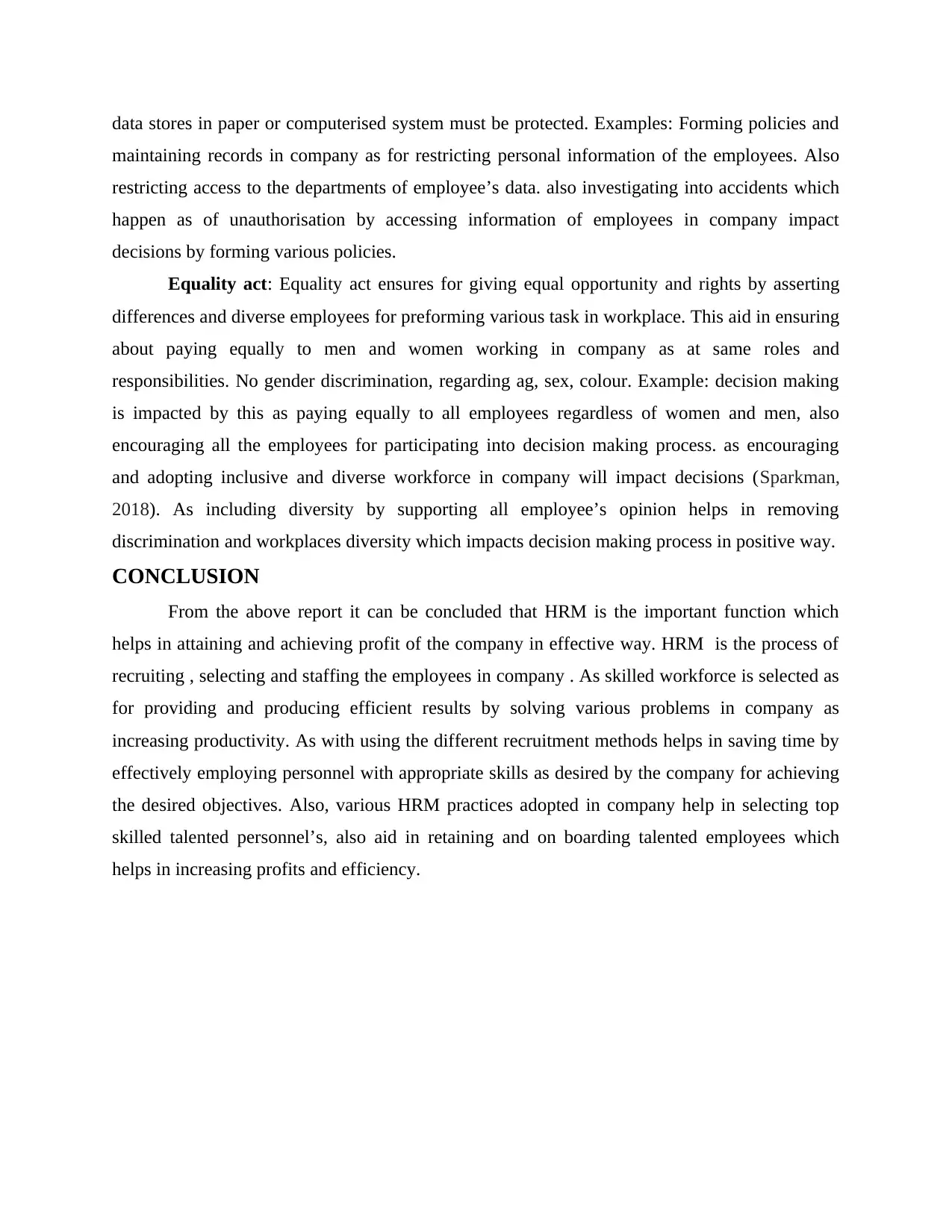
data stores in paper or computerised system must be protected. Examples: Forming policies and
maintaining records in company as for restricting personal information of the employees. Also
restricting access to the departments of employee’s data. also investigating into accidents which
happen as of unauthorisation by accessing information of employees in company impact
decisions by forming various policies.
Equality act: Equality act ensures for giving equal opportunity and rights by asserting
differences and diverse employees for preforming various task in workplace. This aid in ensuring
about paying equally to men and women working in company as at same roles and
responsibilities. No gender discrimination, regarding ag, sex, colour. Example: decision making
is impacted by this as paying equally to all employees regardless of women and men, also
encouraging all the employees for participating into decision making process. as encouraging
and adopting inclusive and diverse workforce in company will impact decisions (Sparkman,
2018). As including diversity by supporting all employee’s opinion helps in removing
discrimination and workplaces diversity which impacts decision making process in positive way.
CONCLUSION
From the above report it can be concluded that HRM is the important function which
helps in attaining and achieving profit of the company in effective way. HRM is the process of
recruiting , selecting and staffing the employees in company . As skilled workforce is selected as
for providing and producing efficient results by solving various problems in company as
increasing productivity. As with using the different recruitment methods helps in saving time by
effectively employing personnel with appropriate skills as desired by the company for achieving
the desired objectives. Also, various HRM practices adopted in company help in selecting top
skilled talented personnel’s, also aid in retaining and on boarding talented employees which
helps in increasing profits and efficiency.
maintaining records in company as for restricting personal information of the employees. Also
restricting access to the departments of employee’s data. also investigating into accidents which
happen as of unauthorisation by accessing information of employees in company impact
decisions by forming various policies.
Equality act: Equality act ensures for giving equal opportunity and rights by asserting
differences and diverse employees for preforming various task in workplace. This aid in ensuring
about paying equally to men and women working in company as at same roles and
responsibilities. No gender discrimination, regarding ag, sex, colour. Example: decision making
is impacted by this as paying equally to all employees regardless of women and men, also
encouraging all the employees for participating into decision making process. as encouraging
and adopting inclusive and diverse workforce in company will impact decisions (Sparkman,
2018). As including diversity by supporting all employee’s opinion helps in removing
discrimination and workplaces diversity which impacts decision making process in positive way.
CONCLUSION
From the above report it can be concluded that HRM is the important function which
helps in attaining and achieving profit of the company in effective way. HRM is the process of
recruiting , selecting and staffing the employees in company . As skilled workforce is selected as
for providing and producing efficient results by solving various problems in company as
increasing productivity. As with using the different recruitment methods helps in saving time by
effectively employing personnel with appropriate skills as desired by the company for achieving
the desired objectives. Also, various HRM practices adopted in company help in selecting top
skilled talented personnel’s, also aid in retaining and on boarding talented employees which
helps in increasing profits and efficiency.
Paraphrase This Document
Need a fresh take? Get an instant paraphrase of this document with our AI Paraphraser
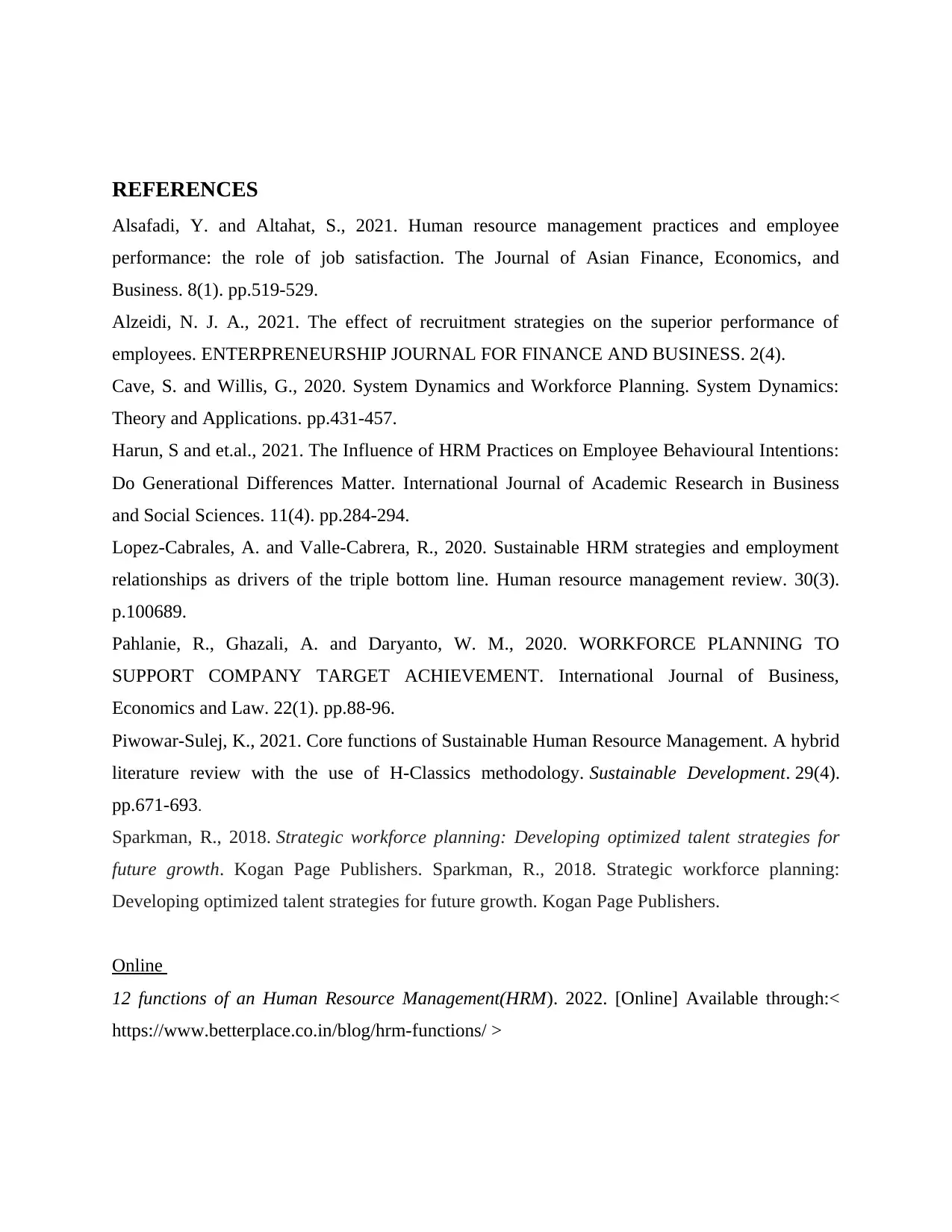
REFERENCES
Alsafadi, Y. and Altahat, S., 2021. Human resource management practices and employee
performance: the role of job satisfaction. The Journal of Asian Finance, Economics, and
Business. 8(1). pp.519-529.
Alzeidi, N. J. A., 2021. The effect of recruitment strategies on the superior performance of
employees. ENTERPRENEURSHIP JOURNAL FOR FINANCE AND BUSINESS. 2(4).
Cave, S. and Willis, G., 2020. System Dynamics and Workforce Planning. System Dynamics:
Theory and Applications. pp.431-457.
Harun, S and et.al., 2021. The Influence of HRM Practices on Employee Behavioural Intentions:
Do Generational Differences Matter. International Journal of Academic Research in Business
and Social Sciences. 11(4). pp.284-294.
Lopez-Cabrales, A. and Valle-Cabrera, R., 2020. Sustainable HRM strategies and employment
relationships as drivers of the triple bottom line. Human resource management review. 30(3).
p.100689.
Pahlanie, R., Ghazali, A. and Daryanto, W. M., 2020. WORKFORCE PLANNING TO
SUPPORT COMPANY TARGET ACHIEVEMENT. International Journal of Business,
Economics and Law. 22(1). pp.88-96.
Piwowar‐Sulej, K., 2021. Core functions of Sustainable Human Resource Management. A hybrid
literature review with the use of H‐Classics methodology. Sustainable Development. 29(4).
pp.671-693.
Sparkman, R., 2018. Strategic workforce planning: Developing optimized talent strategies for
future growth. Kogan Page Publishers. Sparkman, R., 2018. Strategic workforce planning:
Developing optimized talent strategies for future growth. Kogan Page Publishers.
Online
12 functions of an Human Resource Management(HRM). 2022. [Online] Available through:<
https://www.betterplace.co.in/blog/hrm-functions/ >
Alsafadi, Y. and Altahat, S., 2021. Human resource management practices and employee
performance: the role of job satisfaction. The Journal of Asian Finance, Economics, and
Business. 8(1). pp.519-529.
Alzeidi, N. J. A., 2021. The effect of recruitment strategies on the superior performance of
employees. ENTERPRENEURSHIP JOURNAL FOR FINANCE AND BUSINESS. 2(4).
Cave, S. and Willis, G., 2020. System Dynamics and Workforce Planning. System Dynamics:
Theory and Applications. pp.431-457.
Harun, S and et.al., 2021. The Influence of HRM Practices on Employee Behavioural Intentions:
Do Generational Differences Matter. International Journal of Academic Research in Business
and Social Sciences. 11(4). pp.284-294.
Lopez-Cabrales, A. and Valle-Cabrera, R., 2020. Sustainable HRM strategies and employment
relationships as drivers of the triple bottom line. Human resource management review. 30(3).
p.100689.
Pahlanie, R., Ghazali, A. and Daryanto, W. M., 2020. WORKFORCE PLANNING TO
SUPPORT COMPANY TARGET ACHIEVEMENT. International Journal of Business,
Economics and Law. 22(1). pp.88-96.
Piwowar‐Sulej, K., 2021. Core functions of Sustainable Human Resource Management. A hybrid
literature review with the use of H‐Classics methodology. Sustainable Development. 29(4).
pp.671-693.
Sparkman, R., 2018. Strategic workforce planning: Developing optimized talent strategies for
future growth. Kogan Page Publishers. Sparkman, R., 2018. Strategic workforce planning:
Developing optimized talent strategies for future growth. Kogan Page Publishers.
Online
12 functions of an Human Resource Management(HRM). 2022. [Online] Available through:<
https://www.betterplace.co.in/blog/hrm-functions/ >
1 out of 11
Related Documents
Your All-in-One AI-Powered Toolkit for Academic Success.
+13062052269
info@desklib.com
Available 24*7 on WhatsApp / Email
![[object Object]](/_next/static/media/star-bottom.7253800d.svg)
Unlock your academic potential
Copyright © 2020–2025 A2Z Services. All Rights Reserved. Developed and managed by ZUCOL.





